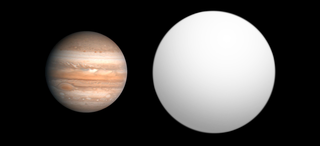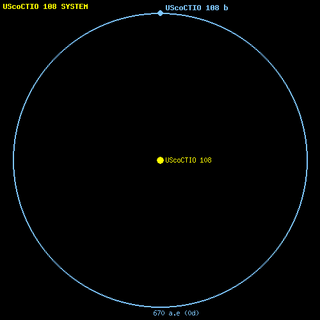
Brown dwarfs are substellar objects that are not massive enough to sustain nuclear fusion of ordinary hydrogen (1H) into helium in their cores, unlike a main-sequence star. Instead, they have a mass between the most massive gas giant planets and the least massive stars, approximately 13 to 80 times that of Jupiter (MJ). However, they can fuse deuterium (2H) and the most massive ones can fuse lithium (7Li).

A rogue planet is an interstellar object of planetary mass which is not gravitationally bound to any star or brown dwarf. Rogue planets originate from planetary systems in which they are formed and later ejected. They can also form on their own, outside a planetary system. The Milky Way alone may have billions to trillions of rogue planets, a range the upcoming Nancy Grace Roman Space Telescope will likely be able to narrow down.
70 Ophiuchi is a binary star system located 16.6 light years away from the Earth. It is in the constellation Ophiuchus. At magnitude 4 it appears as a dim star visible to the unaided eye away from city lights.

2M1207, 2M1207A or 2MASSW J12073346–3932539 is a brown dwarf located in the constellation Centaurus; a companion object, 2M1207b, may be the first extrasolar planetary-mass companion to be directly imaged, and is the first discovered orbiting a brown dwarf.

2M1207b is a planetary-mass object orbiting the brown dwarf 2M1207, in the constellation Centaurus, approximately 170 light-years from Earth. It is one of the first candidate exoplanets to be directly observed. It was discovered in April 2004 by the Very Large Telescope (VLT) at the Paranal Observatory in Chile by a team from the European Southern Observatory led by Gaël Chauvin. It is believed to be from 3 to 10 times the mass of Jupiter and may orbit 2M1207 at a distance roughly as far from the brown dwarf as Pluto is from the Sun.

A sub-brown dwarf or planetary-mass brown dwarf is an astronomical object that formed in the same manner as stars and brown dwarfs but that has a planetary mass, therefore by definition below the limiting mass for thermonuclear fusion of deuterium . Some researchers call them rogue planets whereas others call them planetary-mass brown dwarfs. They are sometimes categorized as Y spectral class brown dwarfs.

The Scorpius–Centaurus association is the nearest OB association to the Sun. This stellar association is composed of three subgroups and its distance is about 130 parsecs or 420 light-years. Using improved Hipparcos data, Rizzuto and colleagues analysed nearby stars more closely, bringing the number of known members to 436. They doubt the need to add a subclassification because they found a more continuous spread of stars.
A substellar object, sometimes called a substar, is an astronomical object the mass of which is smaller than the smallest mass at which hydrogen fusion can be sustained. This definition includes brown dwarfs and former stars similar to EF Eridani B, and can also include objects of planetary mass, regardless of their formation mechanism and whether or not they are associated with a primary star.

UScoCTIO 108 is a binary system, approximately 470 light-years away in the Upper Scorpius (USco) OB association. The primary, UScoCTIO 108A, with mass around 0.06 solar masses, is a brown dwarf or low-mass red dwarf. The secondary, UScoCTIO 108B, with a mass around the deuterium burning limit of 13 Jupiter masses, would be classified as either a brown dwarf or an extrasolar planet.
1RXS J160929.1−210524 is a pre-main-sequence star approximately 456 light-years away in the constellation of Scorpius.

The Rho Ophiuchi cloud complex is a complex of interstellar clouds with different nebulae, particularly dark nebulae which is centered 1° south of the star ρ Ophiuchi, which it among others extends to, of the constellation Ophiuchus. At an estimated distance of 131 ± 3 parsecs, or 460 light years, it is one of the closest star-forming regions to the Solar System.

A planetary-mass object (PMO), planemo, or planetary body is, by geophysical definition of celestial objects, any celestial object massive enough to achieve hydrostatic equilibrium, but not enough to sustain core fusion like a star.
HIP 78530 b is an object that is either a planet or a brown dwarf in the orbit of the star HIP 78530. It was observed as early as 2000, but the object was not confirmed as one in orbit of the star HIP 78530 until a direct imaging project photographed the star in 2008. The image caught the attention of the project's science team, so the team followed up on its initial observations. HIP 78530 b orbits a young, hot, bright blue star in the Upper Scorpius association. The planet itself is over twenty-three times more massive than Jupiter, orbiting eighteen times further from its host star than Pluto does from the Sun by the estimates published in its discovery paper. In this predicted orbit, HIP 78530 b completes an orbit every twelve thousand years.

CFBDSIR 2149-0403 is a free-floating planetary-mass object or possibly a high-metallicity, low-mass brown dwarf in the constellation Aquarius. Originally, it was thought to be part of the AB Doradus moving group (ABDMG) as indicated by its position and proper motion, but the same team that discovered the object and conjectured its membership in the group has now rejected that hypothesis due to newer measurements. Without that membership, the age and mass of the object cannot be constrained. There is insufficient evidence to demonstrate that CFBDSIR 2149-0403 formed as a planet and was subsequently ejected.

Luhman 16 is a binary brown-dwarf system in the southern constellation Vela at a distance of approximately 6.5 light-years from the Sun. These are the closest-known brown dwarfs and the closest system found since the measurement of the proper motion of Barnard's Star in 1916, and the third-closest-known system to the Sun. The primary is of spectral type L7.5 and the secondary of type T0.5 ± 1. The masses of Luhman 16 A and B are 33.5 and 28.6 Jupiter masses, respectively, and their ages are estimated to be 600–800 million years. Luhman 16 A and B orbit each other at a distance of about 3.5 astronomical units with an orbital period of approximately 27 years.

K2-33 is an extremely young pre-main-sequence star located about 456 light-years (140 pc) away from the Earth in the constellation of Scorpius. It is known to host one planet, a super-Neptune, named K2-33b. It is also notable for its young age.
HD 142250 is a star in the constellation Scorpius. It has a visual apparent magnitude of 6.1, being visible to the naked eye only in excellent seeing conditions. From parallax measurements, it is located 486 light-years (149 parsecs) away from Earth. This distance, together with the star's proper motion, indicate that HIP 77900 is a member of the Upper Scorpius subgroup of the Scorpius–Centaurus association, the nearest OB association to the Sun. This subgroup is the youngest of the three of the association, with an estimated age of 11 million years.
2MASS J11011926–7732383 AB is a brown dwarf binary about 600 light-years distant in the constellation Chamaeleon. The wide binary pair is separated by about 240 astronomical units. The system was the first discovery of a brown dwarf binary with a separation greater than 20 au. The discovery gave fundamental insights into the formation of brown dwarfs. Previously it was thought that such wide binary brown dwarfs are not formed or at least are disrupted at ages of 1-10 Myrs. Together with other wide binaries, such as Oph 162225-240515 or UScoCTIO 108, the existence of this system was inconsistent with the ejection hypothesis, a proposed hypothesis in which brown dwarfs form in a multiple system, but are ejected before they gain enough mass to burn hydrogen. The ejection hypothesis predicted a maximum separation of 10 au for brown dwarf binaries.
HIP 79098 is a binary star in the constellation Scorpius. It has a visual apparent magnitude of +5.88, being visible to the naked eye under very dark skies. From parallax measurements by the Gaia spacecraft, it is located approximately 500 light-years from Earth.













